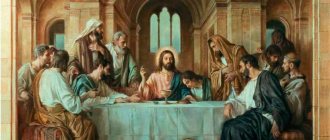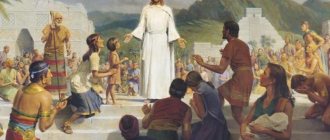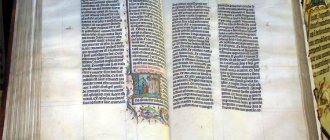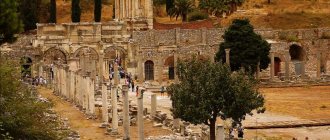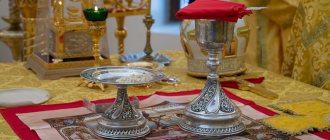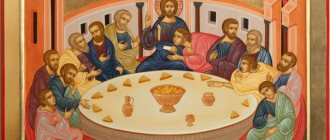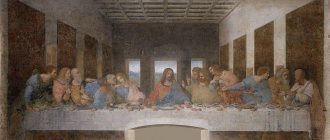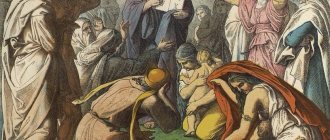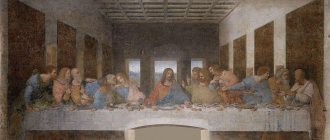PARTICIPLE. THE LAST SUPPER
Communion, Supper, Lord's Table Communion, the Lord's Supper, was instituted on the night before Jesus died.
According to the Synoptic Gospels, this happened on the eve of Easter, i.e. this meal was the Passover meal (Matthew 26:18ff; Mark 14:12ff; Luke 22:7ff). The difference in dating that John's Gospel supposedly reveals (13:1-30; cf. 18:28) is probably due to the use of an ancient calendar.
The Apostle Paul says that the supper was instituted by the Lord Himself (1 Cor 11:23ff.), and therefore calls it “the Lord’s table” (1 Cor 10:21) or “the Lord’s Supper” (1 Cor 11:20).
It should be noted that the Greek the word deipnon does not mean the evening time of the day, so the translation “the table of the Lord” is more appropriate, especially if we take into account that Paul also speaks of the “cup of the Lord” (1 Cor 10:21; 11:27).
I. EASTER AS A BACKGROUND
EASTER AS A BACKGROUND
The festive meal of Jesus (taken on the eve of the Passover holiday), like the corresponding meal in the ancient Church, points to the Passover of Israel (Matt 26:17; Mark 14:12; Luke 22:1; 1 Cor 5:7), which was established by God before the exodus of the Israelites from Egypt (Exodus 12:3-24).
The Israeli holiday of Passover provides a backdrop for understanding the Lord's Supper:
1) Passover of Israel - when the people of the Old Testament, after 430 years of Egyptian slavery (Exodus 12:40), set out on a journey through the desert to the promised land, then on the night before the exodus, a lamb without blemish had to be slaughtered in every house.
The blood of the lamb was to be sprinkled on the lintel and doorposts.
Lamb meat baked over a fire was to be eaten with unleavened bread and bitter herbs.
When, on the night of the Exodus, God struck with a destructive ulcer the firstborn throughout the land of Egypt, then, seeing blood on the crossbars of the doors, He passed by these houses;
2) The Passover of God's New Testament people: “Christ is our Passover sacrificed for us,” writes Paul (1 Cor. 5:7).
Just as the blood of the Passover lamb saved the Israelites on the night before the exodus from Egypt, so the blood of Jesus saves all believers of the New Testament. Christ is the Passover Lamb of the New Testament, sacrificed (according to the Gospel of John) on the Feast of Passover.
According to John 19:30ff., it can be assumed that Jesus died on the cross at the hour when the Israelites slaughtered the Passover lambs in the temple.
Jesus gave His life along with His blood for us (Lev 17:11; 1 Pet 1:18ff).
The blood of Jesus Christ cleanses our lives from sin (1 John 1:7) and saves us (Heb 9:13ff; 13:12).
Through this sacrificial death of Jesus, believers are again given direct access to the sanctuary, i.e. to God Himself (Matt. 27:51; Heb. 10:19).
So, at the price of the blood of Jesus, i.e. at the cost of His life, we are given everything: redemption, cleansing, salvation and participation in God's glory.
II. RELATIONSHIP WITH DESERT WALKING
In his allegorical interpretation, Paul relates the Lord's Supper to the events that took place during the period of the Israelite people's wanderings in the wilderness (1 Cor 10:3ff.).
He speaks of spiritual food and spiritual drink “from the spiritual subsequent stone,” indicating that this stone represents Christ.
What manna from heaven was for the Old Testament people in the wilderness, so is participation in the Lord’s Supper for God’s new people—a living source of strength drawn from the remembrance of the Lord’s patience and victory.
There is also a hint here that we are dealing with a meal that creates unity among believers (“And they all ate the same spiritual food; and they all drank the same spiritual drink”).
The Lord's Supper is a meal of the Church of Christ , celebrated in remembrance of the death of Jesus.
Just as the Old Testament people of God were commanded to celebrate the Passover in eternal remembrance of the exodus from Egypt (Exodus 12:24ff., 42), so the New Testament Church must eternally remember the death of the Lord: “Do this in remembrance of Me!” (Luke 22:19).
Despite the fact that these words are not in the first Gospels of Mark and Matthew, Paul clearly indicates in the earliest known reference to the Lord’s Supper that he received these words from the Lord Himself (1 Cor 11:23ff.) .
If Jesus Himself had not commanded His disciples to periodically repeat this meal, it would not be possible to explain why the ancient Church from the very beginning constantly performed the remembrance as a matter of course (Acts 2:42,46; 20:7).
When the Lord's Supper is celebrated, during the meal believers remember the great feat of salvation that God accomplished in Christ.
Nevertheless, the sacrifice of Jesus remains a one-time event, once and for all completed:
“So Christ, having once offered Himself as a sacrifice to take away the sins of many, will appear a second time, not for the atonement of sin, but for salvation to those who wait for Him” (Heb. 9:28).
The death of Jesus is unique, but the Church must constantly remember His sacrifice as it gathers for the Lord's table.
IV. EXPRESSION OF INVOLVEMENT
The Greek word koinonia in its original meaning expresses the concept of “communication, participation .
In a shared meal, the church community experiences both its participation in the forgiveness given by God and the unity of believers as members of the body of Christ (1 Cor. 10:16 et seq.).
The symbol of the Church, as a single body, is a loaf of bread.
Perhaps the idea of “one bread - one body” was the starting point for the image of the Church as the body of Christ, using which Paul clearly shows the unity of Christians (1 Cor 12:12 et seq.).
By receiving the Holy Spirit, we become members of the body of Christ and inherit an indissoluble unity with our Head in His life and in the sacrifice He made.
“Unity means getting together every few days and having a meal” (Karl Heim).
V. CONFIRMATION OF FORGIVENESS
Paul says: “For as often as you eat this bread and drink this cup, you proclaim the death of the Lord until He comes” (1 Cor 11:26) and “This is My body, which is broken for you” (1 Cor 11:24).
Central to this proclamation is the cross of Christ. Jesus was put to death as a thief - and this for us!
“This cup is the new covenant in My blood” (1 Cor 11:25).
Thus, Communion (the Lord's Supper) is both a proclamation of the New Covenant made by God with people at Calvary, and at the same time the gospel of the atoning death of Jesus.
When God made a covenant with Israel on Mount Sinai, the blood of sacrificial animals was shed as confirmation (Exodus 24:8).
The New Testament was likewise certified (Heb. 9:15ff.).
The Old Testament brought Israel into fellowship with God and transformed them into the people of God.
The New Testament applies to all humanity.
VI. EXPRESSION OF JOY
This refers to the joy associated with the future coming of Jesus Christ.
“For as often as you eat this bread and drink this cup, you proclaim the death of the Lord until He comes” (1 Cor 11:26).
These words set the time limit of the Lord's Supper with the second coming of Jesus and the rapture of His Church, the earthly form of the Lord's Supper will receive its consummation. She will be perfected in God's glory (Luke 13:28ff; 2Tim 2:12; Rev 19:6ff).
Even on that night, when Jesus celebrated the Lord’s Supper with His disciples, He spoke about the fact that one day He would again share bread and wine with them, but in a new way, and this would happen in the “Kingdom of God” (Matt 26:29; Mark 14 :25; Luke 22:16).
Therefore, the despondency and despair of the disciples on the night of betrayal, when the Lord spoke at dinner about His still incomprehensible suffering, was illuminated by hope for a glorious future.
From that moment on, the disciples who took part in the meal were literally overwhelmed with unearthly joy. Jesus promised to meet them again at a festive meal in the glory of the Father.
Every time the believers in the ancient Church gathered to remember the death of the Lord, their eyes were turned to the great table of joy that Jesus had promised for His own.
Through participation in the Lord's Table, confidence in the wonderful future was expressed in his joyful anticipation.
VII. WHO IS THE LORD'S SUPPER FOR?
Symbolizing Divine salvation, the Lord's Supper, on the one hand, is intended for the Church itself, and on the other, for the invisible world:
1) this solemn act is a symbolic expression of the forgiveness and redemption received by the Church herself.
Obviously, the early Christians did not celebrate the Lord's Supper in public. Only members of the community had the right to take part in the meal.
No matter how many times we come to the Lord’s table, each time the Lord Himself anew gives us confirmation of our salvation.
Bread and wine speak to us through the language of symbols: just as it is true that we break bread, it is also true that Jesus allowed himself to be cruelly tortured and accepted death for our sake.
Just as it is true that we drink wine, it is also true that He shed blood for our sake, accepting reproach and being abandoned by everyone.
2) The Lord's Supper is also the unity of the children of God before the invisible world.
According to the testimony of the New Testament, we know that God's angels and demons watch over what God is doing through Christ's Church (Matt. 18:10; 1 Cor. 11:10; Eph. 2:2; 6:12; 1 Pet. 1:12; Heb. 1 :14).
The Church of Christ should serve as a clear example to both the world of angels and the servants of Satan, showing what the wisdom of God is capable of (Eph 3:10).
Therefore, it can be said that when the Church gathers at the Lord's table, the eyes of the invisible world are directed towards it.
What to pray for?
How does the Last Supper icon help?
- First of all, like any other, it gives us the opportunity to focus on communicating with God, to tell Him about our secret thoughts, worries and joys, and to find peace of mind in prayer.
- If the icon hangs in the kitchen, the housewife can read a short prayer, asking for blessings on the work she has begun every time she starts cooking.
- If in the dining room, as already mentioned, they pray in front of the image before and after the meal.
- In a church where the Last Supper is traditionally placed at the Royal Doors, parishioners turn to it in order to receive the blessing to correctly receive the Holy Gifts.
- And before the image you can ask for forgiveness of sins, both in the temple and at home.
You can pray about everything that lies in a person’s soul.
WINE OF THE JEWS
WINE OF THE JEWS
Juice was obtained from grapes (Isa. 63:2; Rev. 14:19,20), and they were eaten fresh or dried (Num. 6:3; Deut. 23:25). Dried grapes, i.e. raisins were pressed into cakes (1 Samuel 25:18, 30:12, in the Synodal translation - “bundles of raisins”).
The first bunches ripened by July, but the main harvest took place in September and could last until October.
It was a time of joy (cf. Isaiah 16:9,10), especially when the grapes began to be crushed, either with a press or with their feet.
The ripe grapes were cut (Jer 6:9) and placed in a winepress, which consisted of a flat vat with holes to drain the juice, which flowed into another vat below.
As a rule, both vats were carved from stone.
The men crushed the grapes with their bare feet as they walked over the layer of grapes (Neh. 13:15; Job 24:11; Is. 63:3), while they chanted to work in rhythm (see Is. 16:10; Jer. 25:30; 48 :33).
“The blood of grapes” (Gen. 49:11) dyed their skin and clothing red (Isa. 63:1-3).
The squeezed juice was collected in a vat below, and then it was filled into leather bottles (Job 32:19; Matthew 9:17) or earthenware jugs.
There it was left to ferment, and then poured into other vessels (Jeremiah 48:11 et seq.), and at the bottom of the old vessels there remained a sediment that served as a fermentation element (yeast.)
Later, a press was used to obtain juice.
TYPE OF TRANSLATION
They drank grape juice fresh [Heb. tirosh] , drawing it from the grindstone. It was brought into the sanctuary as firstfruits (Num. 18:12; Neh. 10:38). Having fermented, the juice turned into wine [Heb. Yayin] is an alcoholic drink that causes intoxication (Gen. 9:21).
“The fruit of the vine” (Matthew 26:29; Mark 14:25) is an expression adopted by the Jews from ancient times to designate wine, which was consumed during liturgical celebrations, for example, at the Passover meal and on the occasion of the beginning of the Sabbath.
The Bible often speaks of spiced wine (Ps. 74:9; Song 8:2) or mixed wine (Prov. 23:30; Song 7:3; Isa. 65:11), but which spices and which ones? we are talking about mixing, there is no exact data.
At the same time, a distinction is made between wine and “strong drink ,” which was made from other fruits (for example, dates), honey or grain (Isa. 28:7; 29:9).
The names of grape varieties were usually associated with the names of the areas where they grew (Eze 27:18; Hos 14:8).
It is impossible to speak unambiguously about the presence of wine cellars in Palestine, based only on the text of the Bible.
The stock of wine mentioned in 1 Chronicles 27:27 may indicate the existence of such a cellar.
Song 2:4 speaks of “the house of feasting,” i.e. about the room where the wine was stored.
It is unclear, however, whether this was a cellar.
Wine cellars were discovered during excavations at Gibeon.
They were pits similar to water collectors in which wine jugs were stacked; From above these pits were covered with stone slabs.
USAGE
Bread, wine, and olive oil (oil) were staple foods in biblical times (2 Chronicles 2:9; Ps 103:14ff; Lamentations 2:12); wine is praised as a gift of God (Gen 27:28; Deut 8:7-10; Ps 103:15; Eccl 9:7; cf. John 2:1-11), it, like a drink offering, is included in every burnt offering (Ex 29:38-41) and should be accompanied by the joy of eating together before the Lord (Deut 14:26).
Wine was also used as a healing agent (Luke 10:34; 1 Tim 5:23; cf. Proverbs 31:6). But often during feasts at the royal court and in the houses of rich people, the amount of wine consumed was exceeded (Isaiah 28:7ff; Am 6:6); The Bible strongly warns against such abuse (Prov. 20:1; 23:29-35; Eph. 5:18).
The priests were forbidden to drink wine and strong drinks while performing their ministry (Lev. 10:8-11), the Nazarites were forbidden to drink wine and eat grapes in any form (Numbers 6:3ff; Judges 13:4), the Rechabites also did not drink any wine (Jer 35).
Maundy Thursday in Church...
In the Calendar of Great Lent, a separate day of Holy Week is dedicated to the memory of the festive meal, which was once secretly celebrated in Jerusalem. In 2022, it falls on April 21, which means that on this day we will again remember with reverence the sacrament performed by the Savior for his disciples; empathize with his suffering on the cross; mourn death; rejoice in the resurrection and try to join Christ through confession and the Eucharist.
SYMBOL OF MEMORIES
SYMBOL OF MEMORIES
MONUMENTS FROM CONCRETE
On Leninsky Prospect of the capital, a monument to the first cosmonaut of the planet, Yuri Gagarin, rose to the skies. It is built from titanium, the most durable metal on earth, to leave the memory of this man for many generations.
In the Alexander Garden of the Kremlin, every passerby passes the Tomb of the Unknown Soldier, where the eternal flame burns. And this is also a monument erected in honor of those who died defending their homeland. Near the Kitay-Gorod metro station there are stone figures of two elders. On the pedestal we read: “Cyril and Methodius.”
These two great men first created the Cyrillic alphabet and translated the Holy Scriptures into Slavic.
However, all such memorials sooner or later collapse and fall into disrepair. Jesus Christ decided to leave a monument about Himself, creating one that will remain as long as this planet exists. The Lord's Supper (Communion) became such a monument.
While man uses rare and expensive stones and metals to build monuments, Jesus chose ordinary things: bread and grape juice when choosing materials for His monument. Wheat and grapes grow almost everywhere in the world, so the memory of Jesus can be honored everywhere.
People build monuments from the strongest materials available to them. Christ, on the contrary, chose very fragile and unstable components. Bread quickly becomes moldy and stale. Once cut, grape juice sours and spoils in a short time.
This means that Jesus did not count on the durability of His monument, due to the fragility of the substances of its components. Rather, He understood that the preservation of His monument would depend on the love of God in the hearts of His followers.
HOLY CANNIBALISM
Mixing imagery and literal language in Bible study is a serious mistake.
Let's consider the topic of erroneously assigning literal meaning to texts that are clearly figurative in nature.
The day after the great miracle of feeding a multitude of people with a few loaves and fishes, crowds of people came for Christ to the western shore of the Sea of Galilee. Jesus rebuked people for being more interested in material things than in spiritual things.
26 Jesus answered and said to them, “Truly, truly, I say to you, you seek Me, not because you saw miracles, but because you ate bread and were filled.” (John 6:26)
Then the Lord began to talk about the “bread of life” and called Himself this “bread.”
48 I am the bread of life. (John 6:48)
Among other things, the Savior said:
“Unless you eat the flesh of the Son of Man and drink His blood, you have no life in you; He who eats My flesh and drinks My blood has eternal life” (verses 53-54).
Some students were extremely surprised by such statements. They called these words “strange,” and it was obvious that they had difficulty accepting them (verse 60). Many of the disciples were so disgusted by this condition that they walked away from Jesus and “walked with Him no more” (verse 66).
What was their problem? They literally interpreted the figurative statement.
By the way, they were not the last who also misunderstood this command.
Some use this text to support their doctrine of so-called "transubstantiation," the theory that the elements of the sacrament are actually transformed into the flesh and blood of Christ during the Lord's Supper.
Bertrand Conway wrote: “A careful study of the entire chapter [John 6] points to the need for a literal interpretation of the words 'eating flesh' and 'drinking blood'" (p. 248).
However, a “careful study” of this chapter actually suggests the opposite.
+In verse 54, the words “eating” and “drinking” are present participles, which means that the disciples were to eat His “flesh” and drink His “blood” at that very moment in time and continue to do so continuously.
A literal translation might sound something like this: “ He who continues to eat My flesh and drink My blood .”
The disciples were not literally eating the flesh and drinking the blood of the Lord at that point in time! Therefore, figurative meaning must be applied here.
+This chapter of John's Gospel says that eating flesh and blood results in "life." However, in this same context, “life” is described as a consequence of accepting the “words” of Christ, that is, His teachings (verse 63).
Thus, it becomes clear that the consumption of His flesh and blood is identical to the assimilation of His holy instructions. These statements are figurative expressions denoting the acceptance of the gospel.
+The same conclusion follows from the phrase “abides in Me, and I in him” (verse 56). This relationship is a consequence of consuming the “flesh” and “blood” of Christ. However, in another passage, John equates the “in me” and “in you” relationship with “keeping His commandments.”
24 And whoever keeps His commandments abides in Him, and He in him. And we know that He abides in us by the spirit that He gave us. (1 John 3:24)
It should also be noted that some Christians, when leading the sacrament, quote passages from the sixth chapter of John's Gospel as the basis for the constituent elements of the Lord's Supper. Although they do so with the best of intentions, they misuse the given context, which does not specifically refer to the Lord's Supper.
IN MY MEMORY
A number of denominations also misinterpret another set of New Testament texts relating to Christ's institution of the sacrament.
26 And while they were eating, Jesus took bread and blessed it, broke it, and gave it to the disciples, saying, “Take, eat: this is My body.” 27 And taking the cup and giving thanks, he gave it to them and said, “Drink from it, all of you, 28 for this is My Blood of the New Testament, which is shed for many for the remission of sins.” 29 But I tell you, from now on I will not drink of this fruit of the vine until that day when I drink new [wine] with you in the kingdom of My Father. (Matt. 26:26-29)
22 And while they were eating, Jesus took bread, blessed it, broke it, gave it to them, and said, “Take, eat.” this is My Body. 23 And he took the cup, gave thanks, and gave it to them: and they all drank from it. 24 And he said to them, “This is my blood of the new testament, which is shed for many.” 25 Truly I say to you, I will no longer drink of the fruit of the vine until that day when I drink new wine in the kingdom of God. (Mark 14:22-25)
19 He also said to this one, “Be you also over the five cities.” 20 A third came and said: Master! here is your mine, which I kept wrapped in a handkerchief (Luke 19:19,20)
We are talking about the following words of the Savior: “ Take, eat: this is My body. ... this is My blood of the new testament, which is shed for many for the remission of sins .” And in this case, a mistake is made in which the figurative is perceived as literal.
In this context, “bread” and “this fruit of the vine” become symbols of the body and blood of the Savior. This is quite obvious when you consider the following facts.
+Those foods that the disciples were to eat could not be the flesh and blood of the Lord in the literal sense of the word; He was still in His body, and His blood had not yet been shed.
+In connection with this bread and fruit of the vine, Christ instructed the disciples: “Do this in remembrance of Me.”
Compare
19 And he took the bread and gave thanks, broke it and gave it to them, saying, “This is My body, which is given for you; do this in remembrance of Me. (Luke 22:19)
24 And having given thanks, he broke it and said: Take, eat, this is My Body, broken for you; do this in remembrance of Me. 25 He also took the cup after supper, and said, “This cup is the new covenant in My blood; Do this whenever you drink, in remembrance of Me. (1 Cor. 11:24,25)
These words anticipate the use of the prescribed elements after the establishment of the church (cf. Luke 22:30), when Christ will no longer be with them, and for this reason they will need a “remembrance” of Him.
30 That ye may eat and drink at My table in My kingdom, and sit on thrones judging the twelve tribes of Israel.
(Luke 22:30)
+According to the teachings of the Catholic Church, as soon as the words of the Savior are spoken: “this is my body... this is my blood,” the bread and the fruit of the vine become the physical flesh and blood of the Lord. However, even after Jesus spoke these words, the contents of the cup were still “the fruit of the vine” (Matthew 26:29).
29 But I tell you, from now on I will not drink of this fruit of the vine until that day when I drink new [wine] with you in the kingdom of My Father. (Matt. 26:29)
+The truth is that Christ used figurative language. The trope used here is “metaphor”. The word “is” (and its form “am”) here means “to symbolize; personify." Compare Jesus' use of this word: “I am the good shepherd” and “I am the Vine” (John 10:11; 15:5).
Recognizing this trope can prevent deviation from the simple truth of the Gospel.
DRINK THIS CUP
As we begin to consider matters pertaining to the communion evening, it is appropriate to touch upon the beliefs of a small minority in the church regarding the vessels used for the fruit of the vine.
Some brothers claim that only one vessel can be used when distributing the fruit of the vine. Proponents of this view place great importance on the fact that Jesus took the “cup” (singular) at the institution of the supper. This single beverage container is said to set a precedent for all time. Supposedly, one cup became a symbol of the entire New Testament - one covenant for the people of God.
At the heart of this concept, which has unfortunately divided God's people, is the lack of understanding that the container or vessel is devoid of any spiritual significance.
The use of the word "cup" in this connection is a form of metonymy, when one is used instead of the other, that is, the container denotes its contents.
We often use this trope when we say, “Did he like his tea?” “Yes, he drank a whole cup.” Or: “The kettle is boiling.” When Moses wrote: “... the earth was corrupted” (Gen. 6:11), he, of course, had in mind the people who inhabited the earth. The fact that Christ especially emphasized not the material cup, but its contents, is obvious from the following facts.
+Similar expressions are used for both “bread” and “cup.” The first is to eat, and the second is to drink.
Since the bread (and not the tray) was the focus of the first element, similarly, “this fruit of the vine” (and not the cup containing it) was the focus of the second element.
+The disciples were commanded to “drink from the cup.” We are talking about the drink, not the container, because the “cup” in this case refers to its contents.
+The “cup” in question was “poured out” (Luke 22:20), “divided” (Luke 22:17), and “drank” (Matt. 26:27).
20 Also the cup after supper, saying, “This cup [is] the New Testament in My blood, which is shed for you.” (Luke 22:20)
17 And taking the cup and giving thanks, he said, Take it and divide it among yourselves (Luke 22:17)
27 And he took the cup and gave thanks, and gave it to them and said, “Drink from it, all of you,” (Matt. 26:27)
All these words refer to a liquid, not a solid container.
+The logical consequence of the "one cup" doctrine reveals its inconsistency.
If the use of the word "cup" stipulates that the church should be limited to one "vessel" when administering the sacrament, and the "cup" symbolizes the New Testament, then each church should limit itself to only one copy of the New Testament when teaching the people.
Of course, no one will accept such a conclusion.
We cannot help but be saddened by the fact that the body of Christ was divided over such a minor issue and the reluctance of people to understand the use of a simple trope.
...And in folk traditions
It is not for nothing that Maundy Thursday is also called Clean Thursday. On this day, Christians strive to visit the bathhouse or take a bath at home. If this is not possible, for example if you are traveling, you should at least rinse your face and hands.
The water element is given special attention. On this day, the peasants tried to take a moment and run to a source or to a stream with a bucket: it was believed that “Thursday water” washes away all the sins accumulated over the year, bestows health, and if you throw a worn thing into the river, troubles and adversities will flow away after it .
In memory of the washing of the feet of the apostles, we strive to celebrate the holiday in purity
However, the housewives had no time to go to the river. Thursday became a day of great cooking for them. Cottage cheese for Easter was being ground, Easter cakes were being baked, and savory dishes were simmering on the stove and sizzling in hot oil, which were supposed to be served to household members on the bright holiday. Well, other family members were busy painting eggs, because until the time it would be possible to give family, friends and acquaintances the main Easter treat in a bright shell, there was not much time left...
A FEW RESULTS
Such simple symbols that Jesus chose to remember His suffering, the reasons for His death and resurrection, have a very deep meaning.
No one will argue that today it is quite easy to bake bread without yeast and squeeze the juice from grapes. But every Christian should understand the figurative meaning of these products.
Related article: Why was there unleavened bread at the Lord's Supper?
Symbolically, yeast represents sins. Jesus walked His path without sin and became a true sacrifice. His body had no sin, just as bread has no yeast. His blood is pure, just as the juice is pure and unfermented.
In the Bible, “wine” has three meanings:
- familiar to each of us today - ordinary juice,
- fermented juice, that is, alcoholic wine
- and “fruit of the grape,” a common juice for rituals such as Passover.
Jesus celebrated Passover with his disciples and during this period, according to Jewish tradition, there could be no alcoholic drinks on the table. There was unleavened bread (matzo), bitter herbs and ordinary grape juice.
The approved example of the early Christians was to have a ritual meal every first day of the week, every Sunday.
Supper, communion or sacrament , this is usually what this part of the Divine Service is called. However, the Apostle Paul, condemning the behavior of the Christians of Corinth, makes it clear that this is not just an ordinary feast, but the Lord's table.
That is, the original meaning of this entire action is the joint sharing of food: not the chaotic absorption of food, but a conscious understanding of the symbols and community with believers around the table.
Christians in the first century did not have work schedules like today, such as 9:00 a.m. to 6:00 p.m. They worked from sunrise to sunset. Most of the believers were poor and even ordinary bread was a luxury at that time. In Corinth, due to a misunderstanding of the purpose of partaking of the Lord's Table, many ate first, while others did not even get to eat.
The time of the meal was also determined by the capabilities of the first Christians and fell on dinner. The New Testament is not clear about the timing of the sacrament. The very word “Lord’s Supper” does not carry any meaning of the time of day! Communion is a meal!
We specially scheduled the time of our Divine Service for the morning, so that at lunchtime we could go to another city for the next Divine Service. Both churches had the Lord's Table.
I know that other churches even have three services a day: in the morning, at lunch and in the evening - so that everyone has time.
Initially, in our congregation the juice was poured into small glasses before the common communion prayer. Afterwards, one of the brothers gave his arguments to say a prayer first, and only then pour the juice into glasses.
In the meeting we decided that there would be no sin in this. And they began to pour out the juice after the prayer.
The material on this topic turned out to be very extensive and, if possible, I will try to add chapters to the current post.
Several passages from the Bible on the topic of fasting
I greatly desired to eat this Passover with you before My suffering
14 And when the hour came, He lay down, and the twelve Apostles with Him, 15 and said to them, “I have greatly desired to eat this Passover with you before I suffer, 16 for I tell you that I will no longer eat it until it is fulfilled in the Kingdom.” God's. 17 And he took the cup and gave thanks, and said, “Take it and divide it among yourselves. 18 For I tell you, I will not drink of the fruit of the vine until the kingdom of God comes.” 19 And he took the bread and gave thanks, broke it and gave it to them, saying, “This is My body, which is given for you; do this in remembrance of Me. 20 Also the cup after supper, saying, “This cup [is] the New Testament in My blood, which is shed for you.” (Luke 22:14-20)
unless you eat the flesh of the Son of man and drink his blood
53 Jesus said to them, “Truly, truly, I say to you, unless you eat the flesh of the Son of Man and drink his blood, you have no life in you.” 54 He who eats My flesh and drinks My blood has eternal life, and I will raise him up at the last day. 55 For My Flesh is truly food, and My Blood is truly drink. 56 He who eats My Flesh and drinks My Blood abides in Me, and I in him. 57 Just as the living Father sent Me, and I live by the Father, [so] whoever eats Me will live by Me. 58 This is the bread that came down from heaven. Not as your fathers ate manna and died: whoever eats this bread will live forever. (John 6:53-58)
whoever eats this bread or drinks this cup of the Lord unworthily
18 For, first of all, I hear that when you come together to church, there are divisions among you, which I partly believe. 19 For there must also be differences of opinion among you, so that the wise may be revealed among you. 20 Further, you gather [so that it] does not mean to eat the Lord's supper; 21 For everyone hastens before [others] to eat his food, [so] [that] some are hungry, and others are drunk. 22 Do you not have houses to eat and drink? Or do you neglect the church of God and humiliate the poor? What should I tell you? Should I praise you for this? I won't praise you. 23 For I received from the Lord what I also passed on to you, that the Lord Jesus on the night in which he was betrayed took bread 24 and when he had given thanks, he broke it and said, “Take, eat, this is my body, for you.” broken; do this in remembrance of Me. 25 He also took the cup after supper, and said, “This cup is the new covenant in My blood; Do this whenever you drink, in remembrance of Me. 26 For as often as you eat this bread and drink this cup, you proclaim the death of the Lord until He comes. 27 Therefore whoever eats this bread or drinks this cup of the Lord unworthily will be guilty of the Body and Blood of the Lord. 28 Let a man examine himself, and in this way let him eat of this bread and drink of this cup. 29 For whoever eats and drinks unworthily eats and drinks condemnation for himself, not considering the Body of the Lord. 30 For this reason many of you are weak and sick, and many die. 31 For if we judged ourselves, we would not be judged. 32 But being judged, we are punished by the Lord, lest we be condemned with the world. 33 Therefore, my brethren, when you gather together to supper, wait for one another. 34 But if anyone is hungry, let him eat at home, so that you do not gather together for condemnation. I'll arrange the rest when I come. (1 Cor. 11:18-34)
isn't there communion
15 I speak to [you] as men of understanding; Judge for yourself what I say. 16 Is not the cup of blessing which we bless a communion of the Blood of Christ? Is not the bread that we break a communion of the Body of Christ? 17 There is one bread, and we, who are many, are one body; for we all partake of one bread. (1 Cor. 10:15-17)
Where to place the icon?
Do you need an icon of the Last Supper in your home? If you are a believer and want to add it to your home iconostasis, such a question should not arise. Of course you need it!
However, let’s make a reservation right away: there are no strict rules on this topic. There is only a tradition that requires that in the home of an Orthodox Christian there should be an image of Jesus Christ, the Mother of God and the Holy Saints. Whether it will be St. Nicholas the Wonderworker, especially revered by the Russian people, the saints whose names are borne by the owner of the house and members of his family, or anyone else, depends only on you. There is also a place in this series for the apostles, captured in one of the most significant, exciting moments: the reception of the first Holy Gifts on this earth.
Place an icon in the dining room to pray before meals. Or in the kitchen, where ordinary, but so homely and warm breakfasts and dinners are held. Or on your home iconostasis - why not?
Some families have kept truly precious relics for many decades.
By the way, the “Last Supper”, along with the “Holy Trinity,” is allowed to be placed above the faces of the Savior and the Mother of God - this image is so highly valued.
The inner side of the sacrament
1) The need for Communion of the Holy Mysteries.
The Holy Fathers explain that demons are afraid of three things: baptism, the cross and communion. But often people, due to their depravity and inattention, destroy the power of the grace of the sacraments, and therefore demons can again approach them and dominate them.
In the biography of St. Macarius the Great, there are his words to one woman who suffered cruelly from the spell of a sorcerer: “You have been exposed to misfortune because you have not received the Holy Mysteries for five weeks.”
2) The importance and meaning of Holy Communion.
In the reflections on the Divine Liturgy of Bishop Seraphim Zvezdinsky, there is a description of the vision of one ascetic elder, which clearly characterizes the meaning of Communion of the Holy Mysteries for a Christian.
The importance of Communion. The ascetic saw “a sea of fire, the waves rose and seethed, presenting a terrible sight. On the opposite bank there was a beautiful garden. From there you could hear the singing of birds and the scent of flowers. The ascetic hears a voice: “Cross this sea.” But there was no way to go. He stood for a long time wondering how to cross, and heard the voice again. “Take the two wings that the Divine Eucharist has given: one wing is the Divine Flesh of Christ, the second wing is His Life-giving Blood. Without them, no matter how great the feat, it is impossible to achieve the Kingdom of Heaven.”
3) Conditions for Communion:
Orthodox faith, i.e. acceptance of what the Creed and other Church dogmas state.
